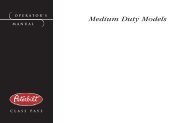Peterbilt Model 320 Operator's Manual after 8-07 - Peterbilt Motors ...
Peterbilt Model 320 Operator's Manual after 8-07 - Peterbilt Motors ...
Peterbilt Model 320 Operator's Manual after 8-07 - Peterbilt Motors ...
Create successful ePaper yourself
Turn your PDF publications into a flip-book with our unique Google optimized e-Paper software.
Engine Cooling System<br />
ELC Extender<br />
Add ELC extender if necessary at the maintenance interval<br />
under "PART 8: MAINTENANCE AND SERVICE".<br />
Coolant Filter<br />
If your vehicle came with a non-chemical filter (“blank filter”),<br />
replace it only with a blank filter at the interval specified<br />
in "PART 8: MAINTENANCE AND SERVICE". Never<br />
use filters that contain SCAs in an ELC filled system.<br />
Topping Off<br />
WARNING! Removing the fill cap on a hot engine<br />
can cause scalding coolant to spray out<br />
and burn you badly. If the engine has been in<br />
operation within the previous 30 minutes, be<br />
very careful in removing the fill cap. Protect<br />
face, hands, and arms against escaping fluid<br />
PART 8: MAINTENANCE AND SERVICE<br />
and steam by covering the cap with a large,<br />
thick rag. Do not try to remove it until the surge<br />
tank cools down if you see any steam or coolant<br />
escaping. In any situation, remove the cap very<br />
slowly and carefully. Be ready to back off if any<br />
steam or coolant begins to escape.<br />
NOTE: If frequent topping off is necessary and<br />
there are no visible signs of coolant leaks when<br />
the engine is cold, check for leaks with the engine<br />
operating at normal temperature.<br />
Top off a cooling system when coolant is no longer visible<br />
in the sight glass of a surge tank (if equipped) on a cold<br />
engine. With the engine cold, top up with premixed coolant<br />
of the desired freeze protection concentration. Add coolant<br />
through the pressure cap neck of the surge tank or recovery<br />
bottle. The surge tank or recovery bottle is on top of the<br />
radiator, on the firewall, on the service module, or on the<br />
front of the cab (see next illustration).<br />
– 168 – Y53-6015 R(08/<strong>07</strong>)
















